Dictamnus, White Dittany, Bai Xian Pi 白鲜皮Polemonium of the ancients; FraxinellaBai Xian Pi (Root-bark of the Chinese Dittany) |

|
 Herbarius latinus, Petri, 1485
Herbarius latinus, Petri, 1485 |
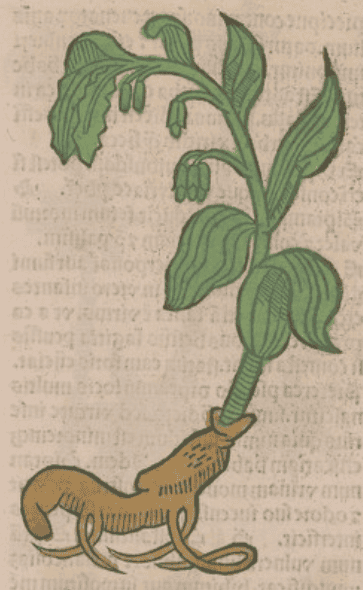 Ortus Sanitatis, Meydenbach, 1491
Ortus Sanitatis, Meydenbach, 1491 |
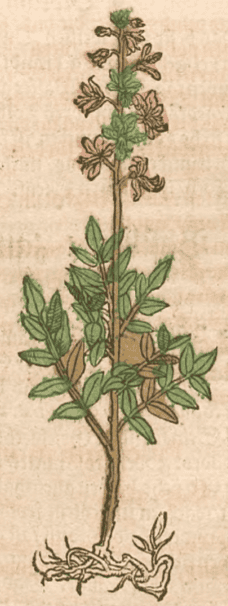 Krauterbuch, Lonitzer, 1578
Krauterbuch, Lonitzer, 1578 |
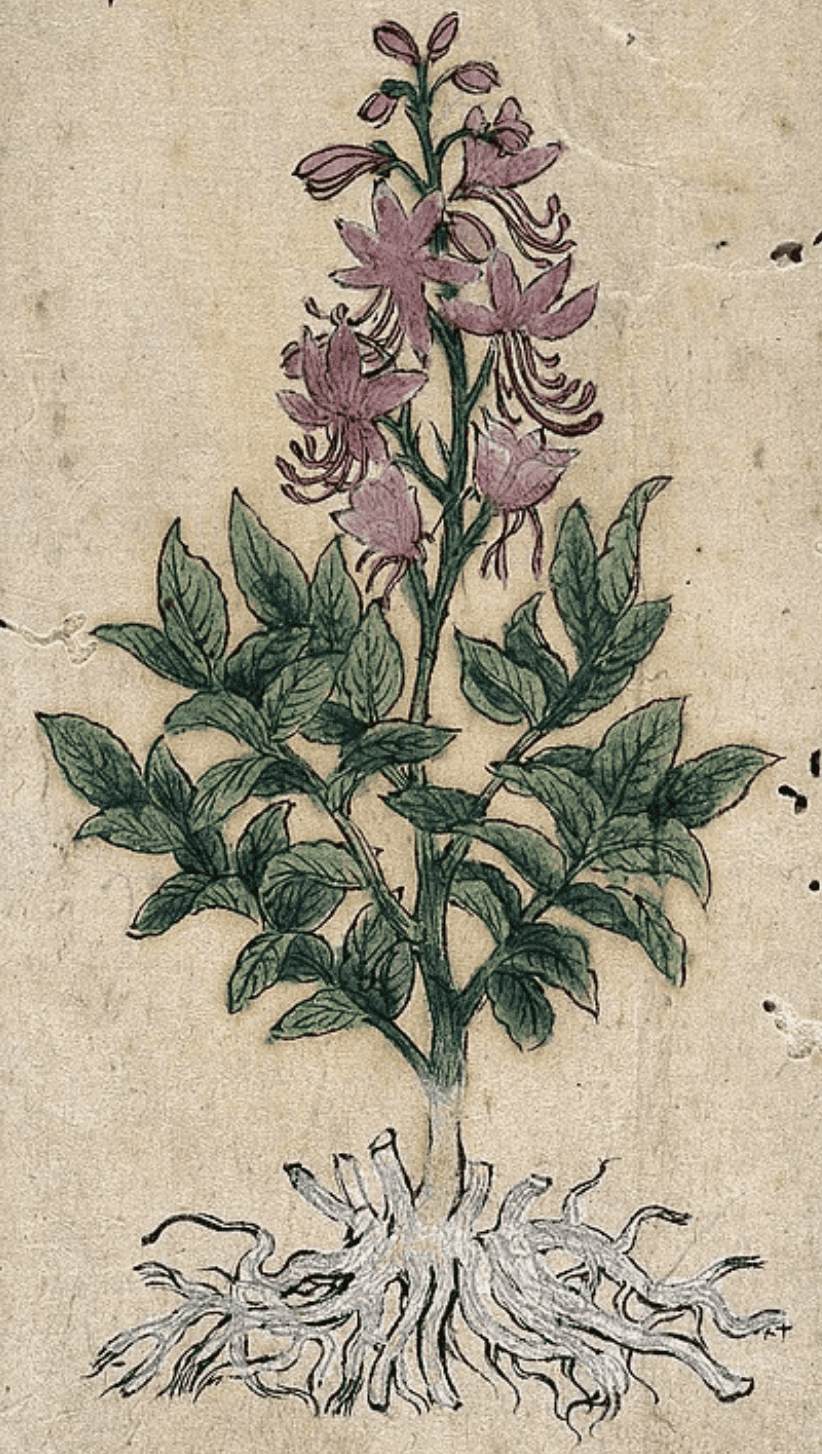 Japanese Herbal, 17trh Century (Welcome)
Japanese Herbal, 17trh Century (Welcome) |
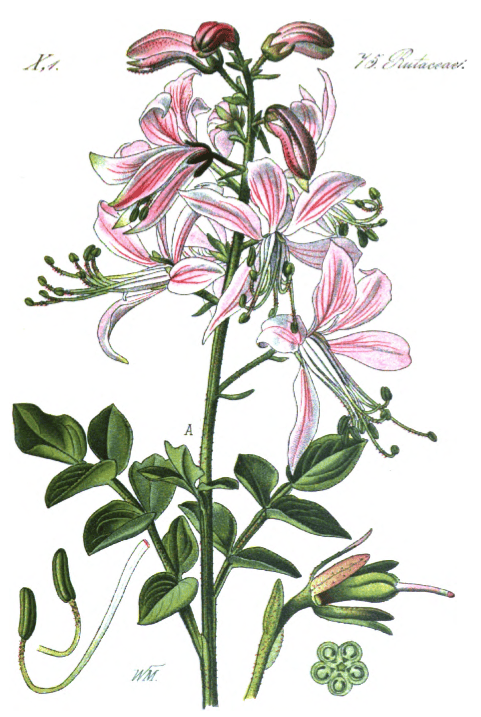 Dictamnus albus
Dictamnus albusFlora von Deutschland (21), Kohler, 1885 |
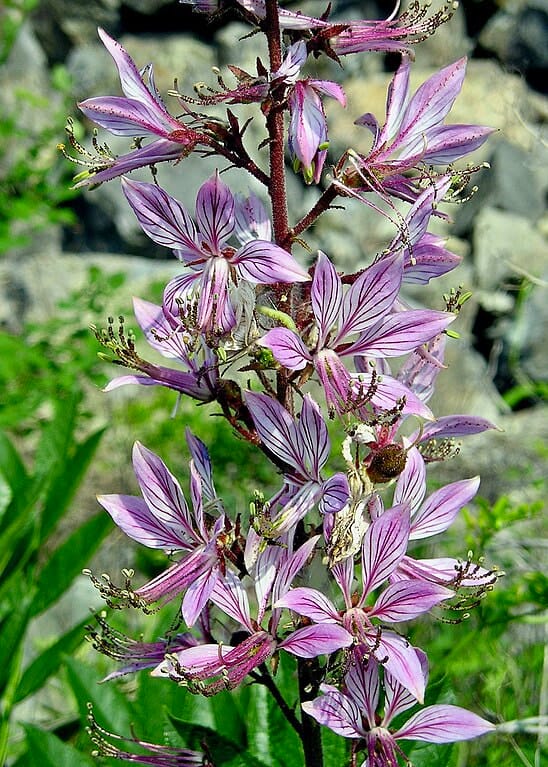 Dictamnus dasycarpus
Dictamnus dasycarpus (Photo by Dr. Alexey Yakovlev) (Wikimedia) |
Botanical name:
Dictamnus spp.
- D. albus (syn. D. fraxinella, Fraxinella dictamnus) (West)
- D. hispanicus (West)
- D. dasycarpus and D. angustifolius are the Chinese White Dittany (TCM)
Parts used:
Root; Chinese use the Root-bark
Temperature & Taste:
Cold (Warm in West), dry. Bitter
“Hot and dry upto the third degree” (Avicenna)
Classifications:
2F. PURIFYING 2M. DRAWING
3A. SUDORIFICS & DIAPHORETICS 3C. ALEXIPHARMICS 3D. CORDIALS & CARDIACS 3G. EMMENAGOGUE
4c. CARDIAC
Preparers and Purgers of Melancholy
TCM:
B. Clear Heat and Toxin
Uses:
1. Clears Wind-Heat, Resists Poison (West, TCM);
-Infectious and Epidemic diseases
-Venomous Bites and Poisons
–diseases of various kinds due to Wind-Heat (Zhen Quan)
-“treats Epidemics” (Da Ming)
-“Dittany expels the viscous fluids from the Chest and Lungs” (Avicenna)
-“It relieves coughing due to disorder of the Lung” (Su Song)
2. Clears Heat from the Blood (TCM, West):
-Eczema, Dermatosis, Urticaria, Scabies, Pustules, Boils etc.
-skin inflammations with Yellow Watery discharge (Chinese Pharmacopoeia)
3. Clears Heat and Damp (TCM, West):
-Jaundice; Hepatitis (TCM, West)
-obstruction of Urine, water retention
-distilled water was used for Stones (Lonicerus)
-acute Rheumatic Arthralgia (Chinese Pharmacopoeia); used for joint diseases in East and West
-“difficulty in moving the extremities” (Ming Yi Bie Lu)
4. Clears Wind and Heat, Calms the Heart:
-Cordial
-Melancholy, Epilepsy, Neurasthenia, Nervousness, Hysteria
-Cheers the Spirits; “revives a languishing nature”
5. Moves the Blood, Promotes Menstruation (West):
-benefits the Womb
-clears obstructions, promotes Menstruation; Amenorrhea, Dysmenorrhea
-promotes Birth and Afterbirth
-has been used for Birth Control in India.
-“it acts as an emmenagogue, and is an expellent of the foetus when dead or lying transversely in the uterus.” (Pliny)
–“Its oral use helps in clearing post-parturition Blood” (Avicenna)
6. Kills Worms
-used as an adjunct for Worms
7. Externally:
-boiled in oil for Bruises, Aches, Sprains, Joint-pain etc.
-externally for inflammatory skin conditions, boils, rashes, carbuncles etc.
-powder with Honey was applied to Ulcers or Fistulas, including those in the corner of the Eyes
-powder with Honey was applied to Ulcers, Abscesses and Cancers of the Nose (Wirtzung)
-Extracts darts and thorns from the skin
-the Chinese Dittany is used topically for vaginal discharge with Itching.
Dose:
Decoction: 4 ½–9 grams
Powder: 1–3 grams
To promote menstruation and expel the afterbirth or a dead fetus, Pliny said the leaves were used.
Substitute:
1. Origanum dictamnus, Dittany of Crete: “It has the virtues of the former [White Dittany] (but not altogether so powerful) and is especially dedicated to the Womb’. (Salmon)
2. “a substitute for mint but is comparatively stronger” (Avicenna)
3. White Dittany was used as a substitute for Anthora.
Comment:
1. The Chinese Dittany Bai Xian Pi (root bark of D. dasycarpus) is Cold, dry, and Bitter. It is used primarily to clear Heat and Poison; used for Sores, Carbuncles and Rashes associated with Damp-Heat (red sores with lots of pus), including those associated with Wind (with itching). It is also used for Damp-Heat vaginal discharge with Pruritis. It is also classically used for Jaundice and Joints disorders.
2. Dictamnus dasycarpus has been given as a synonym of D. alba by some sources (The Plant List). Even the Chinese name of the herb Bai Xian represents the White (Bai) form of Dittany. The uses are similar, and while Western writers regard Dittany as Warm, the Chinese view it as Cold. Despite this, it also ‘mobilizes the Blood’, which perhaps explains its regard of being Warm in the West, as well as its Emmenagogue uses.
3. Western writers regarded White Dittany as being capable of inducing abortion, making it forbidden for use during Pregnancy. Interestingly, Chinese sources do not regard it as contraindicated during Pregnancy. This suggests the Blood-moving effects of the Western variety to be superior. Nevertheless, there is enough similarity in appearance, general uses and chemical composition to regard the Western and Chinese varieties as fairly synonymous in effect, especially when used in Traditional formulas. The fact that the plant has shown toxicity in susceptible individuals suggests it is wise to avoid during Pregnancy.
4. According to a famous Chinese Physician, Dictamnus Bai Xian Pi clears Wind-Heat from the Upper body (head and eyes) and Damp-Heat from the Spleen and Stomach (Rectification of the Meaning of Materia Medica, Zhang Shan-Lei)
Main Combinations:
Dittany is often combined with Angelica (West)
1. Phthisis and Consumption, White Dittany, Angelica, Saffron, Laudanum and the 4 Cold Seeds (‘Proven’, Wirtzung)
2. Epilepsy, White Dittany with Peony, Mistletoe, Valerian (as in Powder for Epilepsy)
3. Strengthen the Heart, benefit the Memory, comfort Nature and strengthens the whole Body, Balm with Bugloss, Scorzonera, White Dittany, Rosemary, Blessed Thistle seed, Fennel seed, Cinnamon, Sandalwood (as in Syrup of Balm)
4. Stomach pain, White Dittany and Wormwood (Herbarius latinus, Petri, 1485)
5. To promote Menstruation, or for Mola:
i. White Dittany, Mugwort, decocted in wine
ii. White Dittany, Angelica, Saffron
iii. White Dittany, Myrrh, Pennyroyal
iv. as a pessary, White Dittany, Myrrh, made into pessaries with Mugwort juice
6. Dysmenorrhea, Uterine growths, White Dittany with Myrrh, Lupin, Madder, Rue, Cumin, Asafetida (as in Troches of Myrrh)
7. Hysteria:
i. White Dittany with Balm and Valerian (Meyer)
ii. White Dittany, Cyperus rotundus, Orange peel
8. Metrorrhagia, White Dittany with Balm, Valerian, Mistletoe and Walnut leaf. (Finsterwalder)
9. Red, Itchy skin lesions:
i. China root with White Dittany root (Bai Xian Pi) (TCM)
ii. Cicada shell (Chan Tui) with White Dittany (Bai Xian Pi), Saposhnikovia Fang Feng
iii. of the Genitals, Kochia Di Fu Zi with Dittany (Bai Xian Pi), Sophora Ku Shen
10. Psoriasis:
i. Sophora Ku Shen with Rehmannia Sheng Di, Paeonia Mu Dan Pi, Paeonia Chi Shao Yao, Dang Gui, Figwort (Xuan Shen), Burdock seed (Niu Ban Zi), White Dittany root (Bai Xian Pi), Saposhnikovia Fang Feng, Cicada shell (Chan Tui) (as in Xiao Yin Pian of the Chinese Pharmacopoeia)
ii. Externally for Psoriasis, prepared Castor seed, White Dittany (Bai Xian Pi), Carrot seed (He Shi), Phellodendron Huang Bai, Dang Gui, Rehmannia Sheng Di Huang, Realgar (Xiong Huang), made into a plaster with Beeswax
11. Edema from Cold, White Dittany with Celery seed (Herbarius latinus, Petri, 1485)
12. Stoppage of Urine, Stones: decoct Saxifrage, Pellitory of the Wall, Water Cress, White Dittany, Fennel seed, Aniseed in white wine; use as a fomentation over the bladder, or it can be injected into the bladder (Wirtzung)
13. Worms:
i. White Dittany (1 dram), form a Bolus with Syrup of Wormwood. (Tractatus de materia medica, Geoffroy, 1741)
ii. White Dittany with Gentian, Aloe, Wormseed, Bull Bile as a plaster applied to the umbilicus (Wirtzung)
Major Formulas:
Syrup of Balm (Fernelius)
Troches of Myrrh (Rhasis)
Electuary of Horehound Diaprassium
Confection of Hyacinth (Confectio de Hyacintho)
Orvietan Antidote
Electuary of Eggs (Maximilian)
Si Wu Xiao Feng Yin
Cautions:
1. Not used during Pregnancy. “Its oral intake or fumigation or use in the form of a suppository causes abortion” (Avicenna)
2. The related Chinese species has been found to induce severe allergic reaction in a very small percentage of people. It should be avoided in peoiple with Liver diseases, or those prone to hypersensitivity or allergies.
3. “may sometimes cause Hematuria” (Avicenna)
Toxicity
1. Hepatotoxic effects have been reported.
–Dictamni Cortex powder-induced liver injury based on integrated evidence chain.
2. Two deaths (in the UK and New Zealand) have been reported with the use of Dictamnus dasycarpus. These cases are believed to have been associated with a rare hypersensitivity. (Bensky)
3. Mutagenic and Phototoxic effects have been reported (Duke)
Main Preparations used:
Distilled Water
